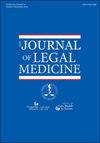Preventing Child Trafficking: A Public Health Approach
IF 0.8
4区 医学
Q3 LAW
引用次数: 0
Abstract
Preventing Child Trafficking: A Public Health Approach, published in 2019, is written by two experts on human trafficking of children: Jonathan Todres, Distinguished University Professor at Georgia State University College of Law, and Angela Diaz, professor of adolescent health at the Icahn School of Medicine and director of the Mount Sinai Adolescent Health Center in New York City. Since the book’s publication, the world has changed dramatically, with the emergence in 2020 of the COVID-19 pandemic and the increased visibility of rampant, systemic racism. These developments underscore the importance of the central message of Preventing Child Trafficking—that prevention must be prioritized in addressing human trafficking of children and that a public health approach is essential in doing so. The authors make their case methodically, with a detailed review of laws, policies, and programs; careful attention to the burgeoning body of relevant evidence; and useful real-life illustrations drawn from their extensive experience with children and adolescents who have been trafficked. At the outset, Todres and Diaz provide useful discussion of terminology, definitions, and the focus of the book. This discussion highlights important issues. For example, use of the word “child” in the title and throughout the book has both advantages and drawbacks. Its use is consistent with terminology in international treaties, U.S. laws, and many official policies and reports. In that context, it refers to individuals under the age of 18 years. This usage is also reflected in a growing concern about exploitation of “children,” not only among policymakers but also on the part of the public. At the same time, as the authors acknowledge, the 18th birthday is often irrelevant when examining who is trafficked. The reality is that many “adolescents,” “youth,” and “young adults” who are over the age of 18 are trafficked and exploited in the same ways as younger children and adolescents who not yet age 18. Even though the terminology does not correspond to legal definitions, addressing the needs of these age groups is just as important when implementing a public health approach to trafficking. The focus of Preventing Child Trafficking, as the authors explain, is primarily on sex trafficking. This foregoes an opportunity to do a deeper exploration of the intersection of sex and labor trafficking and of public health implications and potential with respect to labor trafficking. Addressing forced labor and labor trafficking is an essential component of an effective public health approach to trafficking for several reasons. The risk factors and root causes are similar to those of sex trafficking, and the adverse health consequences are also similar in both nature and severity. The authors acknowledge this and do a good job of highlighting the specific ways in which human trafficking touches all of us—in the clothes and other products we buy, the food we eat—many of which involve forced labor or labor trafficking. Their positioning of the防止贩卖儿童:一种公共卫生办法
《预防拐卖儿童:一种公共卫生方法》于2019年出版,由两位儿童拐卖问题专家撰写:乔治亚州立大学法学院杰出大学教授乔纳森·托德雷斯和伊坎医学院青少年健康教授、纽约市西奈山青少年健康中心主任安吉拉·迪亚兹。自这本书出版以来,世界发生了巨大变化,2020年出现了COVID-19大流行,猖獗的系统性种族主义越来越明显。这些事态发展突出了《防止贩运儿童》的中心信息的重要性,即在处理人口贩运儿童问题时必须优先考虑预防问题,为此必须采取公共卫生措施。作者通过对法律、政策和项目的详细回顾,有条不紊地阐述了他们的观点;仔细关注不断涌现的相关证据;以及从他们与被拐卖的儿童和青少年打交道的丰富经验中得出的有用的真实例子。一开始,Todres和Diaz就术语、定义和本书的重点进行了有益的讨论。这次讨论突出了一些重要问题。例如,在标题和全书中使用“孩子”一词既有优点也有缺点。它的用法与国际条约、美国法律以及许多官方政策和报告中的术语一致。在这方面,它指的是18岁以下的个人。这种用法也反映在决策者和公众对剥削“儿童”的日益关注上。与此同时,正如作者所承认的那样,在调查谁被拐卖时,18岁生日往往是无关紧要的。现实情况是,许多18岁以上的“青少年”和“年轻人”被贩卖和剥削的方式与年龄更小的儿童和未满18岁的青少年一样。尽管这些术语不符合法律定义,但在对贩运问题采取公共卫生办法时,满足这些年龄组的需求同样重要。正如作者解释的那样,《防止拐卖儿童》的重点主要是性交易。这就放弃了深入探讨性与劳工贩运的相互关系以及劳工贩运对公共卫生的影响和潜力的机会。处理强迫劳动和贩运劳工问题是打击贩运人口的有效公共卫生办法的一个重要组成部分,原因如下。风险因素和根本原因与性贩运的风险因素和根本原因相似,对健康造成的不良后果在性质和严重程度上也相似。作者承认这一点,并很好地强调了人口贩运影响我们所有人的具体方式——我们购买的衣服和其他产品,我们吃的食物——其中许多涉及强迫劳动或劳动力贩运。他们的定位
本文章由计算机程序翻译,如有差异,请以英文原文为准。
求助全文
约1分钟内获得全文
求助全文
来源期刊

Journal of Legal Medicine
Multiple-
CiteScore
1.10
自引率
0.00%
发文量
3
期刊介绍:
The Journal of Legal Medicine is the official quarterly publication of the American College of Legal Medicine (ACLM). Incorporated in 1960, the ACLM has among its objectives the fostering and encouragement of research and study in the field of legal medicine. The Journal of Legal Medicine is internationally circulated and includes articles and commentaries on topics of interest in legal medicine, health law and policy, professional liability, hospital law, food and drug law, medical legal research and education, the history of legal medicine, and a broad range of other related topics. Book review essays, featuring leading contributions to the field, are included in each issue.
 求助内容:
求助内容: 应助结果提醒方式:
应助结果提醒方式:


